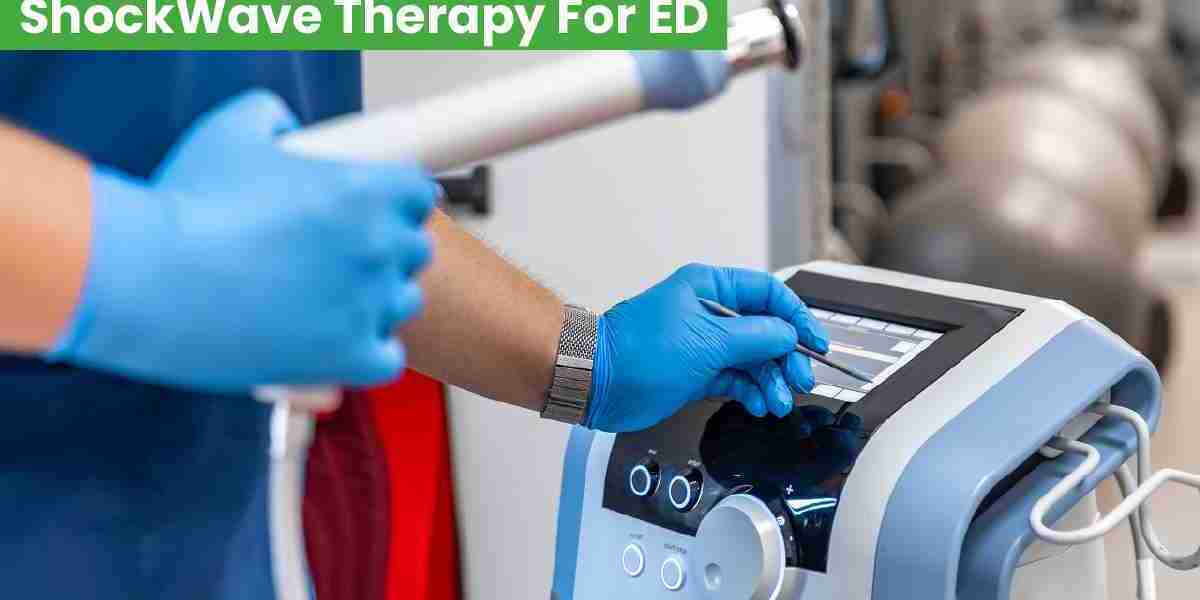Erectile Dysfunction (ED) is one of the most common male sexual health issues worldwide, affecting millions of men across all age groups. It is defined as the persistent inability to achieve or maintain an erection sufficient for satisfactory sexual performance. While traditional treatments such as oral medications (Viagra, Cialis, Levitra), vacuum erection devices, injections, and penile implants remain effective, a growing number of men are now exploring non-invasive and restorative approaches. Among these, shockwave therapy—also known as low-intensity extracorporeal shockwave therapy (Li-ESWT)—has gained increasing attention in recent years as a promising treatment for ED.
This article provides an in-depth look at shockwave therapy for ED—its mechanism, procedure, evidence, benefits, risks, and what men should realistically expect.
Understanding Erectile Dysfunction
Before exploring how shockwave therapy works, it’s important to understand ED’s underlying causes. Erections depend on the interaction of psychological, neurological, hormonal, and vascular factors. The majority of ED cases, especially in older men, have a vasculogenic origin—meaning they are related to poor blood flow in the penile arteries and veins.
Common causes include:
Atherosclerosis (hardening of arteries)
Diabetes
Hypertension
High cholesterol
Obesity
Smoking
Certain medications
Hormonal imbalances
Psychological stress or anxiety
Conventional ED treatments, like oral phosphodiesterase type-5 (PDE5) inhibitors, improve blood flow temporarily. However, they do not cure the condition or restore normal vascular health. Shockwave therapy, on the other hand, aims to repair the underlying cause of ED by enhancing penile blood vessel function and stimulating tissue regeneration.
What is Shockwave Therapy for ED?
Shockwave therapy is a non-invasive treatment that uses low-intensity sound waves to improve blood flow and promote tissue healing. It was originally developed in medicine to treat kidney stones (lithotripsy) and tendon injuries. The version used for erectile dysfunction delivers low-energy acoustic waves to the penis, which are thought to stimulate natural biological healing processes.
Unlike high-intensity shockwaves that break kidney stones, low-intensity shockwaves cause micro-stimulation within the penile tissues. This process encourages the growth of new blood vessels (angiogenesis), enhances existing blood flow, and may even trigger nerve regeneration.
How Shockwave Therapy Works (Mechanism)
The exact mechanisms behind shockwave therapy are still under research, but the following biological effects are believed to contribute to its success:
1. Neovascularization
Shockwaves create mild mechanical stress in the targeted tissues. This microtrauma triggers the release of natural growth factors like vascular endothelial growth factor (VEGF), which stimulates the formation of new blood vessels and improves circulation within the penis.
2. Improved Endothelial Function
The endothelium is the inner lining of blood vessels responsible for releasing nitric oxide—a molecule essential for smooth muscle relaxation and erection. Shockwaves can rejuvenate and improve endothelial cell activity, restoring healthy blood flow regulation.
3. Stem Cell Activation
Research suggests that shockwaves may attract stem cells and progenitor cells to the treated area, helping regenerate damaged or aged tissues in the penile arteries and nerves.
4. Nerve Regeneration
Animal studies have indicated that low-intensity shockwaves may promote nerve healing, potentially benefiting men whose ED has a neurological component.
5. Reduction of Fibrosis
Shockwave therapy may also help reduce penile fibrosis (scar tissue), which can develop in conditions like Peyronie’s disease, further improving erectile function.
The Shockwave Therapy Procedure
Shockwave therapy for ED is performed in a clinic setting and does not require anesthesia, surgery, or downtime. The typical process involves the following steps:
1. Consultation and Assessment
Before starting treatment, a doctor evaluates the patient’s medical history, lifestyle factors, and underlying causes of ED. Blood tests and sometimes penile Doppler ultrasound are used to assess vascular health.
2. Treatment Sessions
During a session:
The patient lies comfortably on an exam table.
A gel is applied to the penis to help conduct the shockwaves.
A handheld device delivers focused or linear low-intensity shockwaves to specific areas of the penis (the shaft and the crura at the base).
Each session typically lasts 15–30 minutes, and patients usually undergo 6 to 12 sessions over several weeks, depending on the treatment protocol.
3. Post-Treatment
There is no recovery time needed. Patients can return to normal activities immediately after each session.
Expected Results and Effectiveness
Many clinical studies have shown that shockwave therapy can improve erectile function scores, particularly in men with mild to moderate vasculogenic ED. Reported improvements include:
Increased ability to achieve and maintain erections
Enhanced response to oral ED medications
Improved penile blood flow (measured via Doppler ultrasound)
Greater satisfaction with sexual performance
Some men notice improvement within a few weeks, while others may experience benefits gradually over several months. Results can last up to 12 months or more, but periodic maintenance sessions may be required.
However, it’s important to understand that outcomes vary. Not all men respond equally, and those with severe nerve damage or advanced diabetes may see limited improvement.
Benefits of Shockwave Therapy
Non-invasive: No needles, surgery, or incisions.
Drug-free: Suitable for men who cannot tolerate oral ED medications.
Safe and Painless: Minimal discomfort, no anesthesia required.
Natural Healing: Targets the underlying cause—poor blood flow—rather than just symptoms.
Long-Term Potential: Promotes vascular regeneration that can have lasting effects.
Quick Procedure: Each session takes less than half an hour.
Improves Spontaneity: Restores natural erections without dependence on pills or devices.
Potential Side Effects and Risks
Shockwave therapy is generally well-tolerated. Most men experience no significant side effects. However, some mild and temporary effects may occur:
Slight pain or discomfort during treatment
Redness or swelling at the treated area
Minor bruising or tingling sensations
These symptoms typically resolve within a few hours to days. Serious complications such as tissue injury, infection, or scarring are extremely rare when performed by trained professionals.
Who is a Good Candidate?
Shockwave therapy is best suited for men who:
Have mild to moderate ED caused by reduced blood flow (vasculogenic ED)
Do not respond well to or cannot tolerate PDE5 inhibitors
Prefer a non-invasive, drug-free treatment option
Have reasonable expectations and understand that results may vary
Men with severe diabetes-related nerve damage, after prostate surgery, or with significant psychological causes of ED may not benefit as much.
Who Should Avoid It?
Shockwave therapy is not recommended for men who:
Have bleeding disorders or are on high-dose blood thinners
Have active penile infections or open sores
Have penile implants
Expect immediate or guaranteed results
A medical consultation is essential to determine eligibility and set realistic expectations.
Treatment Protocols
Because shockwave therapy for ED is still considered an emerging treatment, there is no single standardized protocol. However, common patterns include:
6–12 total sessions
1–2 sessions per week
1,500–3,000 pulses per session
Energy levels: 0.05–0.25 mJ/mm²
Some clinicians recommend a follow-up or “booster” course every 6–12 months, depending on how long results last.
Combining Shockwave Therapy with Other Treatments
For some men, the best results occur when shockwave therapy is combined with other therapies, such as:
Oral PDE5 inhibitors (sildenafil, tadalafil): Shockwaves may enhance drug responsiveness.
Lifestyle modifications: Diet, exercise, quitting smoking, and managing stress improve outcomes.
Hormone optimization: Correcting low testosterone can complement vascular improvements.
Psychological support: Counseling or sex therapy helps when performance anxiety or stress contributes to ED.
Combining restorative (shockwave) and supportive (medication/lifestyle) approaches yields the most sustainable results.
Cost of Shockwave Therapy
The cost varies widely depending on the clinic, device type, and number of sessions. On average:
Per session cost: Ranges from moderate to premium pricing.
Full treatment package: Typically includes 6–12 sessions.
Because it’s considered an elective and emerging therapy, most insurance plans do not cover the cost. Patients should discuss pricing, package deals, and maintenance costs upfront.
How Long Do the Results Last?
The duration of results depends on individual health factors and ED severity. Many men report improvement lasting 6 months to 1 year. Some experience longer-lasting benefits, especially when maintaining a healthy lifestyle. Periodic booster sessions may help sustain improvements.
Comparison with Other Treatments
| Treatment | Type | Effect Duration | Invasiveness | Addresses Root Cause? |
|---|---|---|---|---|
| Oral PDE5 Inhibitors | Medication | Temporary (hours) | Non-invasive | No |
| Injections | Medication | Temporary | Minimally invasive | No |
| Vacuum Device | Mechanical | Temporary | Non-invasive | No |
| Penile Implants | Surgical | Permanent | Invasive | No |
| Shockwave Therapy | Regenerative | Long-lasting (6–12 months or more) | Non-invasive | Yes |
Safety and Regulatory Status
Shockwave therapy devices used for ED are typically approved for general physiotherapy or musculoskeletal purposes, and their use for ED is often considered “off-label.” However, ongoing research supports its safety and potential benefit. When performed by certified and experienced healthcare professionals, it is a low-risk and well-tolerated procedure.
Limitations of the Treatment
While promising, shockwave therapy is not a miracle cure. Key limitations include:
Variable Results: Not all men respond.
Lack of Long-Term Data: Studies are still short to mid-term.
High Cost: Out-of-pocket expense may be significant.
Need for Standardization: Different devices and protocols make comparisons difficult.
Investigational Status: Not yet universally recommended as first-line therapy by major medical societies.
Future of Shockwave Therapy for ED
Research into shockwave therapy continues to expand. Scientists are exploring:
Optimal energy levels and pulse frequencies
Combining Li-ESWT with other regenerative therapies (like PRP or stem cells)
Long-term outcomes over multiple years
Identifying biomarkers that predict treatment success
With time and more evidence, shockwave therapy may become an established first-line or adjunctive treatment for ED, especially for men seeking natural, restorative solutions.
Frequently Asked Questions (FAQ)
1. Does shockwave therapy cure ED permanently?
Not necessarily. It can improve erectile function for months or even years, but results may fade over time and may require maintenance sessions.
2. Is the treatment painful?
No. Most men describe the sensation as mild tapping or tingling. Discomfort is minimal.
3. How soon will I see results?
Some men notice changes after 3–4 sessions, while others may take a few months to experience full benefits.
4. Do I need to take medications with it?
Some men combine shockwave therapy with oral medications for faster or stronger results, but it’s not mandatory.
5. Are there risks of tissue damage?
When performed correctly, shockwave therapy is very safe. The energy levels used are too low to cause tissue injury.
6. Can older men benefit from it?
Yes. Even older men can experience improvement, especially if their ED is primarily due to blood flow issues rather than nerve damage.
7. Is it effective for psychological ED?
Shockwave therapy mainly targets blood flow problems. Men with psychogenic ED may benefit more from counseling or therapy.
Conclusion
Shockwave therapy for erectile dysfunction represents an exciting development in sexual medicine. It offers men a non-invasive, drug-free, and restorative option aimed at improving natural erectile function by repairing blood vessel health and stimulating new tissue growth. Clinical research has demonstrated promising results, especially for men with mild to moderate vasculogenic ED.
However, it is not a guaranteed cure. Outcomes vary, the therapy can be costly, and long-term data are still evolving. Men considering shockwave therapy should consult an experienced urologist or sexual medicine specialist to determine if they are suitable candidates and to discuss expectations realistically.
In summary, shockwave therapy marks a step forward toward regenerative sexual medicine, offering hope for men seeking long-term, natural improvement in their erectile function — but informed decision-making and professional guidance remain essential.





